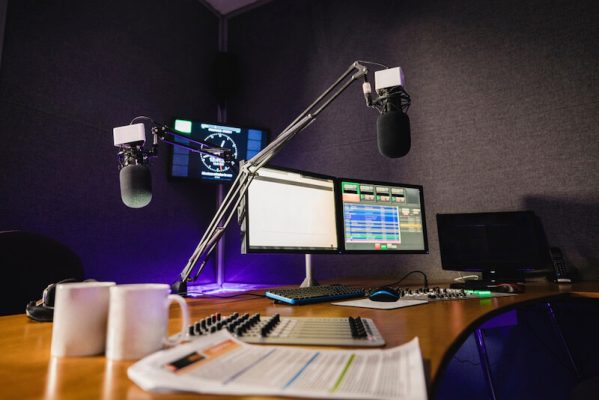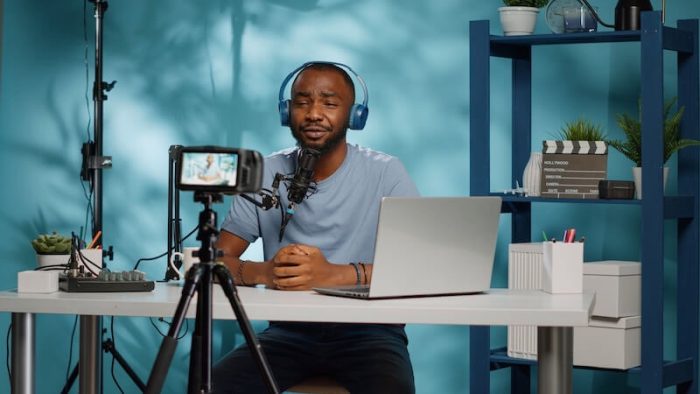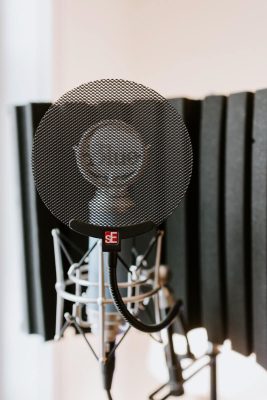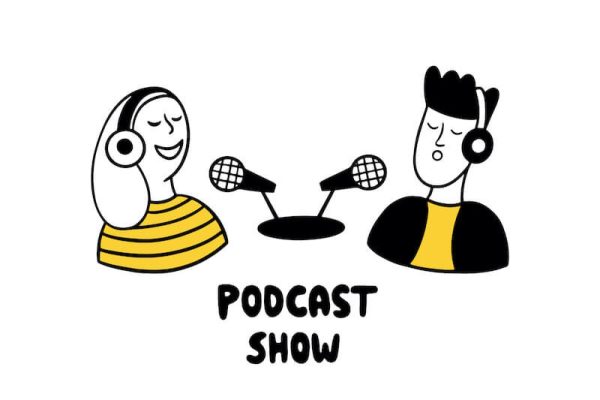https://nasacademy.com/blog/article/how-to-start-a-podcast

So you want to learn how to start a podcast. Maybe it’s your 2022 New Year’s resolution to finally host your own true-crime drama or talk show. Maybe you’ve just started a business and you’re looking to drive awareness for your brand.
Podcasts have become more and more popular over the years – and it doesn’t look like they’ll be slowing down anytime soon. In fact, there are currently over 2,000,000 podcasts out there in the world, and 50% of households in the US listen to podcasts regularly.
So while the podcast market is pretty saturated, it’s clearly an extremely popular medium that, if done right, can be a great supplement to your business. It could even be a great side hustle – or a full-time career.
But what exactly goes into starting a podcast? Let’s take a look at all the necessary steps you need to take your show from idea to reality.

While you might want to jump right into starting your podcast, the key to building a great show is doing your research first. Listen to a lot of podcasts, find what you like, and what you don’t. It’s here that you learn what works in a good show, what doesn’t, and what you want to add to the space.
As you begin your podcast, nail down what your motivation is behind this podcast. Are you doing this as a hobby? Are you aiming to monetize? Build a community? Bring awareness to your brand? While you don’t need to know everything about where you will take your podcast from the start – especially if you’re just experimenting – knowing why exactly you want to start a podcast is going to help you significantly. Focused motivation will help in many ways, including giving you an idea of what you’re going to make your show about, and it keeps you motivated when others would be burned out.
When creating your podcast, the most important thing that you need to decide is what your story is going to be.
Think about what problem you are trying to solve for your listeners. What is your unique perspective that is going to stand out in the podcast world, and what’s going to keep people coming back? So before you start your podcast, take some time to really narrow down your focus, and find your niche.
Think about telling a story only you can tell. Even if the content or genre is similar to others, find what makes you unique, and add it into your podcast. This is what’s going to help keep you passionate, and draw people to your content.
Think about a topic you won’t get tired of. Something that gives you enough room to expand on, and create content for years to come. Your story should be something that can evolve and transform. Find something that is relevant now and, even better, something that could remain relevant for years to come.

While figuring out a podcast topic or story that you’re going to focus on, you also want to think about how exactly you’re going to tell it. Is the podcast just going to be you talking? Will you have a co-host? Are you going to bring on weekly guests? There are various podcast formats and approaches you could take – but whichever you choose, make sure it aligns with your goal and overall story.
Doing all of this at the beginning is going to help you set a direction for your content, make sure you remain consistent in your story, and ensure your audience will know what to expect from you every time your upload day comes around.
If you want to know how to start a podcast that people will actually listen to, you have to make sure your content fits the needs and interests of your audience. This means you need to know your listeners’ problems, and find a way to solve them with whatever story you’re telling – and how you’re telling it.
What’s their mindset? Where do they listen to their podcasts? How much time do they have when they’re listening? Are they on mobile on a busy train? Knowing who you are talking to is how to start a podcast that resonates with people enough to gain traction.
Once you’ve nailed down your story and audience, now it’s time to name your podcast. Remember, your name is what people are going to see on Spotify or Apple Music when they’re searching for a new podcast to listen to.
It’s the name that’s going to be passed around by word of mouth when your show starts to pick up. So, pick a name that’s catchy and memorable – something that reflects your mission. Your name should be unique, and give people an idea of what your podcast is going to be about right away.

If you’re struggling to think of a name, try asking yourself these questions:
Brainstorm all of the possible names that come to mind. When you find something you like, do your research to make sure that name isn’t already taken by another popular podcast.
And remember – rebranding is always possible. While names are important, the most important part in making a podcast is actually starting it. Don’t spend so much time trying to perfect your name that it holds you back from hitting publish.
Visuals, sounds, music, and tone are all very important pieces to creating a podcast. Think about how you are going to package your story and main message. What language are you going to use? If your brand is yourself, speak the language you would speak. Let your personality shine through. If you’re creating a meditation podcast, make sure you’re using calming vocals, sound effects, and use language that isn’t harsh or triggering.
Create a branded intro, outro, and interludes to weave into your podcast, and make music choices that are consistent with your overall tone. By using branded elements and keeping a consistent style throughout, you will get a much more cohesive feel across all of your episodes.

You will also be refining your style and brand as you go, so don’t get too stuck on perfecting these right away. But it’s good practice to look ahead and gather elements in advance that you can pull from and use repeatedly. And remember – your brand is what helps you stand out from the 2,000,000 other podcasts out there, and the little things can make all the difference.
As you begin your podcast, create a schedule for the foreseeable future. Brainstorm a bunch of topics in advance, and make sure that you have a plan for the upcoming months to keep your podcast on track.
Give yourself deadlines, pick your upload days and stick to them. It’s important to build yourself a system that’s manageable right now, and learn how to set realistic goals for yourself in advance. This way, you can keep yourself on top of your deadlines.
So what do you need to start a podcast? What kind of gear is actually required?
As a beginner, this step can be overwhelming.
There’s so many brands, technical jargon, and different types of gadgets you can get to boost your overall production quality. But, if you’re just starting out, don’t worry too much about your gear.
Realistically, if you wanted to, you could start a podcast and edit it with just your phone.

However, investing in some extra equipment can really help to create a better quality podcast that will ultimately help you grow, and gain more traction. If you want to upgrade your equipment but don’t have a lot of money to do it, you can also consider investing in some used gear.
You can sometimes find pieces that are hardly used, and at a fraction of the price of brand new gear.
Here’s the basic gear that you’re going to need:
Microphone – for beginners, the best option is to use a simple USB mic. The Blue Yeti is an incredibly popular and very effective option that you can plug right into your computer, and record directly onto a free audio software. But if you’re looking to go all in, you could invest in more of a professional setup with what’s called dynamic or condenser microphones – which have to be recorded using an audio interface.
Headphones – Invest in a pair of over the ear headphones. Audio Technica or Sony are great options for brands – but there are many others out there, and it’s really up to personal preference.
Mic stands – If you opt for a USB mic like the Blue Yeti, they will normally come with a desk stand already attached. However, if you’re investing in a more professional setup with a dynamic or condenser microphone, you will most likely need to purchase a stand to go with it. You can get a desk stand, floor stand or the typical suspension arm that attaches to your desk that you see podcast hosts using all the time.
Pop filter – Pop filters are the screens that you place over your microphone to reduce any harsh sounds or “pops” of air that come out as you speak into the microphone. You can buy these for relatively cheap online – and some even come in a package along with shock mounts and microphone stands. But there are also many tutorials online and hacks you can do to make your own at home. For example, you can get similar results by stretching out some nylon fabric between you and the microphone.

Computer & audio editing software – you will need a laptop or computer to attach to your audio device, as well as some audio recording software to record onto. Some free versions of audio software are Audacity or GarageBand – but if you’re looking for more industry standard software, Pro Tools or even Adobe Audition are great options.
Whatever gear you get, make sure to sit down and spend some time practicing with it before you go to record your first show – especially if you’re new to tech. And remember: gear is only one part of starting a podcast. Don’t get too tied up in which brand you get, or what microphone is going to sound the best. The most important part of starting a podcast is getting resourceful, using what you have, and making it work.
Now that you have all your gear set up, it’s time to sit down and write your script!

When it comes to podcasting, most of the time it’s best to not sound overly scripted. While it depends on the style of your show, people tend to listen to podcasts to be entertained or learn something new. Unless it’s a scripted radio play, try using points as guides and focus on having a conversation rather than reading a script. It makes it more engaging, allows your personality to shine through, and helps you to project authenticity – making it easier for audiences to connect to you.
Now where should you actually record your podcast? Ideally, find somewhere that is quiet, and where you have a decent amount of furniture or padding around you to avoid unwanted echos.
A great hack if you don’t have a professional recording studio or booth is to record in your closet. The clothes around you will absorb the sound and help to make your audio quality sound more professional. Either that, or you can sit under a blanket, or pin some up around you on the walls behind you. Then, once you’ve set up your gear, it’s time to hit record!
Using whatever audio software you have, take some time to watch audio editing tutorials and learn how to best edit your vocals. Using things like equalizers and compression can really help to boost the sound of your audio – but you have to know how to use the tools properly.

Once you’ve done that, craft up your intros and outros and pick your music and sound effects. Remember to keep your story moving. Editing is where you finally craft your story together, so keep pacing in mind, cut out dead noise in the middle, get creative with your cuts and find interesting ways to arrange your story to keep it engaging.
And most importantly: know when to stop editing and hit publish. You could refine one show forever, but it’s important to just keep moving. You’ll get better at your editing as you do it repeatedly, and you’ll find your groove and editing styles with time.
And now it’s time to upload! You might think that once you complete a podcast, you just go onto Spotify and upload it. But that’s not actually how it works.
When you go to upload a podcast, you actually have to upload it to what’s called a podcast host. A podcast host allows you to upload your podcast onto a server, and then it will distribute it to multiple platforms – so you only have to upload your show once. There are many hosts out there, from Anchor to Buzzsprout. Many will require you to pay for a subscription, but each of these podcast hosts have free options available.
Once you’ve uploaded your podcast and shared it with the podcasting world, now it’s time to tell people about it. If you want to know how to make a podcast that will grow: tell people about it. While it might be intimidating at first, you might be surprised to see the amount of people willing and ready to support you.

Go to networking events and talk to people, bring people on your show to bring awareness – and speak on other people’s podcasts! Collaborating with other creators in similar niches is a great way to get your show noticed and get their audience members to become your listeners too. You can also film your podcast episodes and start uploading them on Instagram or YouTube to bring people over to your show from other platforms.
Whatever you do – be creative, and don’t be afraid to show the amazing content that you’re creating.
And last but not least: be consistent. Upload on your designated upload days, and make sure that your audience can rely on you to keep creating content. Make a plan, give yourself a system to keep yourself going for the long-run. Success comes from consistent actions, and continual effort.
You won’t see results overnight – you may not see them for a while. But if you keep at it, you’re going to start seeing growth before you know it.
5 years ago, the world had 5 million social media creators. Today, that number is over 50 million.
Welcome to the Creator Revolution. Now, for the first time ever, you can actually get a job doing what you love.
You can be a social media manager, a digital marketer on TikTok, or a community manager on Discord. Not only are these the world’s newest jobs, they are guaranteed to be in-demand in future. And they are way more fun than your average 9 to 5, and pay even better! But there hasn’t been one single place to learn all these skills. Until now.
This is the Creator Accelerator Program. We designed this program to help you skyrocket your career as a creator. From learning how to grow on social media platforms, to building a network and accessing job opportunities with the world’s top brands – this immersive program will transform your career in just 5 months.
There’s room for everyone in this Revolution, but don’t waste another day — the Fall Semester starts soon!
By Admin Nas Academy
By Team Nas Academy